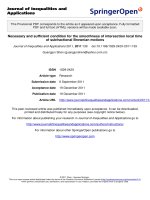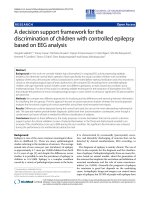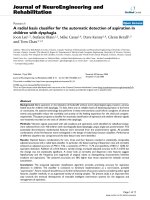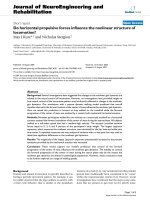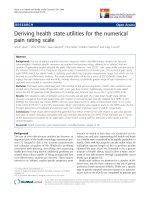Báo cáo toán học: " Remarks on uniform attractors for the 3D nonautonomous Navier-Stokes-Voight equations" pptx
Bạn đang xem bản rút gọn của tài liệu. Xem và tải ngay bản đầy đủ của tài liệu tại đây (292.63 KB, 11 trang )
RESEARC H Open Access
Remarks on uniform attractors for the 3D non-
autonomous Navier-Stokes-Voight equations
Yiwen Dou
1,2
, Xinguang Yang
3*
and Yuming Qin
4
* Correspondence:
3
College of Mathematics and
Information Science, Henan Normal
University, Xinxiang, 453007,
People’s Republic of China
Full list of author information is
available at the end of the article
Abstract
In this paper, we show the existence of pullback attractors for the non-autonomous
Navier-Stokes-Voight equations by using contractive functions, which is more simple
than the weak continuous method to establish the uniformly asymptotical
compactness in H
1
and H
2
.
2010 Mathematics Subject Classification: 35D05; 35M10
Keywords: Navier-Stokes-Voight equations, processes, contractive functions, uniform
attractors
1 Introduction
Let Ω ⊂ R
3
be a bounded domain with sufficiently smooth boundary ∂Ω. We consider
the non-autonomous 3D Navier-Stokes-Voight (NSV) equations that govern the
motion of a Klein-Voight linear viscoelastic incompressible fluid:
u
t
− νu − α
2
u
t
+(u ·∇)u + ∇p = f(t , x), (x, t) ∈ × R
τ
,
(1:1)
∇·u =0, x ∈ , t ∈ R
τ
,
(1:2)
u(t , x)|
∂
=0, t ∈ R
τ
,
(1:3)
u(τ , x)=u
τ
(x), x ∈ , τ ∈ R
τ
.
(1:4)
Here u = u(t, x)=(u
1
(t, x), u
2
(t, x), u
3
(t, x)) is the velocity vector field, p is the pres-
sure, ν > 0 is the kinematic viscosity, and the length scale a is a characterizing para-
meter of the elasticity of the fluid.
When a = 0, the above system reduce to the well-known 3D incompressible Navier-
Stokes system:
u
t
− vu +(u ·∇)u + ∇p = f (t, x), x ∈ , t ∈ R
τ
,
(1:5)
∇·u =0, x ∈ , t ∈ R
τ
.
(1:6)
For the well-posedness of 3D incompressible Navier-Stokes equations, in 1934, Leray
[1-3] derived the existence of weak solution by weak convergence method; Hopf [4]
improved Leray’s result and obtained the familiar Leray-Hopf weak solution in 1951.
Since the 3D Navier-Stokes equations lack appropriate priori estim ate and the strong
Dou et al. Boundary Value Problems 2011, 2011:49
/>© 2011 Dou et al; licensee Springer. This is an Open Access article di stributed under the te rms of the Creative Commons Attribution
License (http://creativecommons .org/license s/by/2.0), which permits unrestricted use, distribution, and reproduction in any medium,
provided the original work is properly cited.
nonlinear property, the existence of strong solution remains open. For the infinite-
dimensional dynamical systems, Sell [5] constructed the semiflow generated by the
weak solution which lacks the global regularity and obtained the existence of global
attractor of the 3D incompressible Navier-Stokes equations on any bounded smooth
domain. Chepyzhov and Vishik [6] investigated the tr ajectory attractors for 3D non-
autonomous incompressible Navier-Stokes system which is based on the works of
Leray and Hopf. Using the weak convergence topology of the space H (see below for
the definition), Kapustyan and Valero [7] proved the existence of a weak attractor in
both autonomous and non-autonomous cases and gave a existence result of strong
attractors. Kapustyan, Kasyanov and Valero [8] considered a revised 3D incompressible
Navier-Stokes equations generated by an optimal control problem and proved the exis-
tence of pullback attractors by constructing a dynamical multivalued process.
However, the infinite-dimensional systems for 3D incompressible Navier-Stokes
equations have not yet completely resolved, so many mathematicians pay attention to
this challenging problem. In this regard, Kalantarov and Titi [9] investigated the
Navier-Stokes-Voight equati ons as an inviscid regularization of the 3D incompressible
Navier-Stokes equations, and further obtained the existence of global attractors for
Navier-Stokes-Voight equations. Recently, Qin, Yang and Liu [10] showed the exis-
tence of uniform attractors by uniform condition-(C) and weak continuous method to
obtain uniformly asymptotical compactness in H
1
and H
2
, Yue and Zhong [11] investi-
gated the attractors for autonomous and nonautonomous 3D Navier-Stokes-Voight
equations in different methods. More details about the infinite-dimensional dynamics
systems, we can refer to [12-27].
Using the contractive functions, we have in this paper established the uniformly
asymptotical compactness of the processes {U(t, τ)}(t ≥ τ, τ Î R) to obtain the existence
of the uniform attractor of the 3D non-autonomous NSV equations.
Main difficulties we encountered are as follows:
(1) how to obtain a contractive function,
(2) how to deduce the uniformly asymptotical compactness from a contractive
function,
(3) how to obtain the convergence of contractive function.
2 Main results
Notations: Throughout t his paper, we set R
τ
=[τ,+∞), τ Î R. C stands for a generic
positive constant, depending on Ω, but independent of t. L
p
(Ω)(1 ≤ p ≤ +∞) is the gen-
eric Lebesgue space, H
s
(Ω) is the general Sobolev space. We set
E := {u|u ∈ ( C
∞
0
())
3
, divu =0}
, H, V, W is the closure of the set E in the topology of
(L
2
(Ω))
3
,(H
1
(Ω))
3
,(H
2
(Ω))
3
respectively. “⇀” stands for weak convergence of sequence.
Let
⊆ L
2
loc
(R, L
2
())
be the hull of f
0
as a symbol space:
= H
+
(f
0
)=
f
0
(t + h)|h ∈ R
L
2
loc
(R,L
2
())
(2:1)
for all
f
0
∈ L
2
loc
(R, L
2
())
,where
[·]
L
2
loc
(R,L
2
())
denotes the closure in the topology of
L
2
loc
(R, L
2
())
.
Under the assumptions of the initial data, the problem (1.1)-(1.4) has a global solu-
tion u Î C([τ,+∞), V). U
f
(t, τ, u
τ
): V ® V denotes the processes generated by the
Dou et al. Boundary Value Problems 2011, 2011:49
/>Page 2 of 11
global solutions and satisfies
u(t , τ ; u
τ
)=U
f
(t , τ , u
τ
)u
τ
,
(2:2)
U
f
(t , s, u
τ
) · U
f
(s, τ , u
τ
)=U
f
(t , τ , u
τ
), ∀ u
τ
∈ , t ≥ τ , τ ≥ 0,
(2:3)
U
f
(τ , τ )=Id, ∀ τ ∈ R.
(2:4)
Let {T(s)} be the translation semigroup on Σ, we see that the family of processes {U
f
(t, τ)} (f Î Σ) satisfies the translation identity if
U
f
(t + s, τ + s)=U
T(s)f
(t , τ ), ∀ f ∈ , t ≥ τ , τ ∈ R,
(2:5)
T(s) = , ∀s ≥ 0.
(2:6)
Next, we recall a simple method to derive uniformly asymptotical compactness which
can be found in [28].
Definition 2.1 Let X be a Banach space and B be a bounded subset of X, Σ be a
symbol space. We call a function j(·,·;·,·) defined on (X × X)×(Σ × Σ) to be a contrac-
tive function on B × B if for any sequence
{x
n
}
∞
n=1
⊂ B
and any {g
n
} ⊂ Σ, there are sub-
sequences
{x
n
k
}
∞
k=1
⊂{x
n
}
∞
n=1
and
{g
n
k
}
∞
k=1
⊂{g
n
}
∞
n=1
such that
lim
k→∞
lim
l→∞
φ(x
n
k
, x
n
l
; g
n
k
, g
n
l
)=0.
(2:7)
We denote the set of all contractive functions on B × B by Contr(B, Σ).
Lemma 2.2 Let {U
f
( t, τ)}(f Î Σ) be a family of processes satisfying the translation
identity (2.5) and (2.6) on Banach space X and has a bounded uniform (w.r.t f Î Σ)
absorbing set B
0
⊂ X. Moreover, assume that for any ε >0,there exist T = T(B
0
, ε) and
j
T
Î Contr(B
0
, Σ) such that
U
f
1
(T,0)x − U
f
2
(T,0)y≤ε + φ
T
(x, y; f
1
, f
2
),
∀ x, y ∈ B
0
, ∀f
1
, f
2
∈ .
(2:8)
Then {U
f
(t, τ)} (f Î Σ) is uniformly (w.r.t. f Î Σ) asymptotically compact in X.
Theorem 2.3 Assume that f Î Σ ⊆ L
2
(R, H), u
τ
Î V, then the problem (1.1)-(1.4) pos-
sesses uniform attractors
A
1
f
(t )
in V .
Theorem 2.4 Assume that f Î Σ ⊆ L
2
( R, H), u
τ
Î W, then the problem (1.1)-(1.4)
possesses uniform attractors
A
2
f
(t )
in W.
3 Proof of Theorem 2.3
In this section, we shall prove Theorem 2.3 by two steps as follows, the first one is to
get the existence of an absorbing ball, the second is to prove the asymptotical com-
pactness by means of a contractive function.
From the property of solutions, we can easily derive that the set class {U
f
(t, τ, u
τ
)} (τ,
≤ t)isaprocessinV for all τ ≤ t. Moreover, the m apping U
f
(t, τ , u
τ
): V ® V is
continuous.
Lemma 3.1 We assume that
{u
n
τ
}⊂V, u
τ
∈ V
and
u
n
τ
u
τ
,f
n
® finL
2
(R, H),
then
Dou et al. Boundary Value Problems 2011, 2011:49
/>Page 3 of 11
U
f
n
(t , τ , u
n
τ
)u
n
τ
U
f
(t , τ , u
τ
)u
τ
weakly star in L
∞
((τ , T); H), ∀ t ≥ τ ,
(3:1)
U
f
n
(·, τ , u
n
τ
)u
n
τ
U
f
(·, τ , u
τ
)u
τ
weakly in L
2
(τ , T; V), ∀ t ≥ τ .
(3:2)
Proof. From the boundedness of the solutions in corresponding topological spaces,
we easily conclude the results. □
Lemma 3.2 As sume f Î L
2
(R, H), u
τ
Î V, then there exists a uniform (w.r.t. f Î Σ)
absorbing set B
0
of processes {U
f
(t, τ, u
τ
)}.
Proof. For all u Î V, multiplying both sides of (1.1) with u and noting that ((u·∇)u,
u) = 0, we derive
d
dt
(u(t)||
2
+ α
2
∇u(t)||
2
)+2ν∇u(t)||
2
≤ 2(f (t), u(t))
≤ 2ν∇u(t)||
2
+
2
νλ
f (t)
2
.
(3:3)
Consequently, for all τ Î R, there holds
u(t)
2
+ α
2
∇u(t)
2
≤ ( u
τ
2
+ α
2
∇u(τ )
2
)+
2
νλ
t
τ
f (ξ )
2
dξ.
(3:4)
Consider the property of the functional 〈·,·〉 + a
1
〈∇·,∇·〉, we get
C
1
·
2
V
≤·, · + α
2
∇·, ∇· ≤ C
2
·
2
V
,0< C
1
≤ C
2
,
and there exists a constant C
0
satisfying C
1
≤ C
0
≤ C
2
, such that
C
0
·
2
V
= ·, · + α
2
∇·, ∇·.
Setting the radius
r
2
= u
τ
2
+ α
2
∇u
τ
2
, we easily get that there exists a constant
C > 0 such that
U
f
(t , τ , u
τ
)
2
V
≤ Cr
2
+
2C
νλ
t
−∞
f (ξ )
2
dξ,
(3:5)
for all u
τ
Î V, t ≥ τ.
Setting
r
2
≤
2
νλ
t
−∞
f (ξ)
2
dξ,
then we denote R the nonnegative number given by
R
2
=
2C
νλ
t
−∞
f (ξ )
2
dξ,
(3:6)
and consider the family of closed balls B
0
in V defined by
B
0
= {v ∈ V |v
V
≤ 2R}.
(3:7)
It is straightforward to check that B
0
is a uniform absorbing ball for the processes
{U
f
(t, τ, u
τ
)}. □
Dou et al. Boundary Value Problems 2011, 2011:49
/>Page 4 of 11
Lemma 3.3 Under the condition of f Î L
2
(R, H), the process {U
f
(t, τ, u
τ
)} generated by
the global solutions for problem (1.1)-(1.4) is uniformly asymptotically compact in V .
Proof. For any initial data
u
i
τ
∈ B
0
(i =1,2)
,letu
i
(t, x)bethecorrespondingsolu-
tions to the symbols f
i
with
u
i
τ
, that is, u
i
(t) is the solution of the problem:
u
t
− α
2
u
t
− νu +(u ·∇) u + ∇p = f
i
(t , x), x ∈ , t ∈ R
τ
,
(3:8)
divu =0, t ∈ R
τ
,
(3:9)
u(t , x)|
∂
=0, t ∈ R
τ
,
(3:10)
u(τ , x)=u
i
τ
(x), τ ∈ R.
(3:11)
Denote
w(t )=u
1
(t ) − u
2
(t ),
(3:12)
then w (t) satisfies the equivalent abstract equations
w
t
+ αAw
t
− νAw + B(u
1
) − B(u
2
)=f
1
(t , x) − f
2
(t , x),
(3:13)
divw =0,
(3:14)
w(t , x)|
∂
=0,
(3:15)
w(τ , x)=u
1
τ
(x) − u
2
τ
(x), τ ∈ R,
(3:16)
where B(u)=(u·∇)u, p has disappeared by the projection operator P.
Setting
E
w
(t )=
1
2
| w(t) |
2
dx +
α
2
2
|∇w(t) |
2
dx.
(3:17)
Multiplying (3.13) by w and integrating over [s, T]×Ω, we deduce
E
w
(T) − E
w
(s)+ν
T
s
|∇w(h)|
2
dxdh
+
T
s
B(u
1
(h)) − B(u
2
(h))
w(h)dxdh
=
T
s
f
1
(h) − f
2
(h)
w(h)dxdh,
(3:18)
where τ ≤ s ≤ T. Then we have
ν
T
τ
|∇w(h) | dxdh ≤ E
w
(τ ) −
T
τ
B(u
1
(h)) − B(u
2
(h))
w(h)dxdh
+
T
τ
f
1
(h) − f
2
(h)
w(h)dxdh.
(3:19)
Dou et al. Boundary Value Problems 2011, 2011:49
/>Page 5 of 11
Hence,
T
τ
E
w
(s)ds =
T
τ
1
2
—w(s)—
2
dx +
α
2
2
—∇w(s)—
2
dx
d
s
≤ C
T
τ
—∇w(s)—
2
dxds
≤ C
E
w
(τ ) −
T
τ
B(u
1
(s)) − B(u
2
(s))
w(s)dxds
+
T
τ
f
1
(s) − f
2
(s)
w(s)dxds
.
(3:20)
Integrating (3.18) over [τ, T] with respect to s, we get
TE
w
(T)+ν
T
τ
T
s
|∇w(h)| dxdhds
≤
T
τ
E
w
(s)ds −
T
τ
T
s
B(u
1
(h)) − B(u
2
(h))
w(h)dxdhds
+
T
τ
T
s
f
1
(h) − f
2
(h)
w(h)dxdhds
≤ C
E
w
(τ ) −
T
τ
B(u
1
(s)) − B(u
2
(s))
w(s)dxds
+
T
τ
f
1
(s) − f
2
(s)
w(s)dxds
−
T
τ
T
s
B(u
1
(h)) − B(u
2
(h))
w(h)dxdhds
+
T
τ
T
s
f
1
(h) − f
2
(h)
w(h)dxdhds.
(3:21)
If we set
C
0
= CE
w
(τ ),
φ(u
1
0
, u
2
0
; g
1
(t), g
2
(t)) = C
−
T
τ
B(u
1
(s)) − B(u
2
(s))
w(s)dxds
+
T
τ
f
1
(s) − f
2
(s)
w(s)dxds
−
T
τ
T
s
B(u
1
(h)) − B(u
2
(h))
w(h)dxdhds
+
T
τ
T
s
f
1
(h) − f
2
(h)
w(h)dxdhds,
(3:22)
then we have
E
w
(T) ≤
C
0
T
+
1
T
φ(u
1
0
, u
2
0
; f
1
(t ), f
2
(t )).
(3:23)
Since the family of processes has a uniformly bounded absorbing set, we choose T
large enough such that
C
0
T
≤ ε,
(3:24)
i.e.,
T ≥
C
0
ε
.
Dou et al. Boundary Value Problems 2011, 2011:49
/>Page 6 of 11
Let u
n
, u
m
be the solutions wit h respect to the initial data
u
n
0
, u
m
0
and symbols f
n
(t),
f
m
(t) Î Σ, m, n = 1, 2, . . . respectively. Then from Lemma 3.1, we can derive
lim
n→∞
lim
m→∞
T
τ
T
s
f
n
(h) − f
m
(h)
u
n
(s) − u
m
(s)
dxdhds =0,
lim
n→∞
lim
m→∞
T
τ
f
n
(s) − f
n
(s)
u
n
(s) − u
m
(s)
dxds =0,
and
lim
n→∞
lim
m→∞
T
τ
B(u
n
(s)) − B(u
m
(s))
×
u
n
(s) − u
m
(s)
dxds
= lim
n→∞
lim
m→∞
T
s
(u
n
(s) ·∇)u
n
(s) − (u
m
(s) ·∇)u
m
(s)
×
u
n
(s) − u
m
(s)
dxds
= lim
n→∞
lim
m→∞
T
s
((u
n
(s) − u
m
(s)) ·∇)u
n
(s) − (u
m
(s) ·∇)
×(u
m
(s) − u
n
(s))
× (u
n
(s) − u
m
(s))dxds
=0,
lim
n→∞
lim
m→∞
T
τ
T
s
B(u
n
(h)) − B(u
m
(h))
u
n
(s) − u
m
(s)
dxdhds
= lim
n→∞
lim
m→∞
T
τ
T
s
(u
n
(h) ·∇)u
n
(h) − (u
m
(h) ·∇)u
m
(h)
×
u
n
(s) − u
m
(s)
dxdhds
= lim
n→∞
lim
m→∞
T
τ
T
s
((u
n
(h) − u
m
(h)) ·∇)u
n
(h) − (u
m
(h) ·∇)
×(u
m
(h) − u
n
(h))
× (u
n
(s) − u
m
(s))dxdhds
=0.
Hence
φ(u
1
0
, u
2
0
; f
1
(t ), f
2
(t )) ∈ Contr(B
0
, )
for the above T.ByLemma2.2andthe
property of the functional 〈·,·〉 + a
2
〈∇·, ∇·〉, the conclusion holds. □
Proof of Theorem 2.3 From Lemmas 3.1-3.3, we can deduce the result easily. □
4 Proof of Theorem 2.4
Similarly to the proof of Theorem 2.3, we easily obtain that the set class {U
f
(t, τ, u
τ
)} (τ
≤ t) is a process in W for all τ ≤ t. Moreover, the mapping U
f
(t, τ, u
τ
): W ® W is con-
tinuous. If we assume that
{u
n
τ
}
isasequenceinW and weakly converges to u
τ
Î W,
f
n
® f in L
2
(R, H), then
U
f
n
(t , τ , u
n
τ
)u
n
τ
U
f
(t , τ , u
τ
)u
τ
weakly in W, ∀ fixed t ≥ τ ,
(4:1)
U
f
n
(·, τ , u
n
τ
)u
n
τ
U
f
(·, τ , u
τ
)u
τ
weakly in L
2
(τ , T; W), ∀ t ≥ τ.
(4:2)
Lemma 4.1 Assume f Î L
2
( R, H), then there exists a global uniform (w.r.t. f Î Σ)
absorbing set B
0
of the process {U
f
(t, τ, u
τ
)}.
Dou et al. Boundary Value Problems 2011, 2011:49
/>Page 7 of 11
Proof. By the Faedo-Galerkin method, the standard elliptic operator theory and the
Poincaré inequality, we get that u belongs to L
2
((τ, T); D(A)) ∩ L
∞
((τ, T); W ), then
using the Gronwall inequality and similar energy method to the proof of Theorem 3.1
in Qin, Yang and Liu [10], we can deduce the boundedness of u and the existence of
absorbing set. □
Lemma 4.2 Under the condition of f Î L
2
(R, H), u
τ
Î W, the process {U
f
(t, τ, u
τ
)}
generated by the global solutions for problem (1.1)-(1.4) is asymptotically compact in W.
Proof. For any initial data
u
i
τ
∈ B
0
(i =1,2)
,letu
i
(t, x)bethecorrespondingsolu-
tions to the symbols f
i
with
u
i
τ
,thatis,u
i
(t) is the solution of the problem (3.8)-(3.11).
Denote A =-Δ and w(t)=u
1
(t)-u
2
(t), then w(t) satisfies the equivalent abstract equa-
tions (3.13)-(3.14).
Setting
E
w
(t )=
1
2
|∇w(t ) |
2
dx +
α
2
2
|Aw(t)|
2
dx.
(4:3)
Multiplying (3.13) by Aw and integrating over [s, T]×Ω, we deduce
E
w
(T) − E
w
(s)+ν
T
s
|Aw(h)|
2
dxdh
+
T
s
(B(u
1
(h)) − B(u
2
(h)))Aw(h)dxdh
=
T
s
(f
1
(h) − f
2
(h))Aw(h)dxdh,
(4:4)
where τ ≤ s ≤ T. Then we have
ν
T
τ
| Aw(h)| dxdh ≤E
w
(τ ) −
T
τ
(B(u
1
(h)) − B(u
2
(h)))Aw(h)dxdh
+
T
τ
(f
1
(h) − f
2
(h))Aw(h)dxdh.
(4:5)
Hence,
T
τ
E
w
(s)ds =
T
τ
1
2
|Aw(s)|
2
dx +
α
2
2
|Aw(s)|
2
dx
ds
≤ C
T
τ
|Aw(s)|
2
dxds
≤ C
E
w
(τ ) −
T
τ
(B(u
1
(s)) − B(u
2
(s)))Aw(s)dxds
+
T
τ
(f
1
(s) − f
2
(s))Aw(s)dxds
.
(4:6)
Dou et al. Boundary Value Problems 2011, 2011:49
/>Page 8 of 11
Integrating (4.4) over [τ, T] with respect to s, we get
TE
w
(T)+ν
T
τ
T
s
|Aw(h)|
2
dxdhds
≤
T
τ
E
w
(s)ds −
T
τ
T
s
(B(u
1
(h)) − B(u
2
(h)))Aw(h)dxdhds
+
T
τ
T
s
(f
1
(h) − f
2
(h))Aw(h)dxdhds
≤ C
E
w
(τ ) −
T
τ
(B(u
1
(s)) − B(u
2
(s)))Aw(s)dxds
+
T
τ
(f
1
(s) − f
2
(s))Aw(s)dxds
−
T
τ
T
s
(B(u
1
(h)) − B(u
2
(h)))Aw(h)dxdhds
+
T
τ
T
s
(f
1
(h) − f
2
(h))Aw(h)dxdhds.
(4:7)
If we set
C
0
= CE
w
(τ ),
φ(u
1
0
, u
2
0
; g
1
(t), g
2
(t)) = C
−
T
τ
(B(u
1
(s)) − B(u
2
(s)))Aw(s)dxds
+
T
τ
(f
1
(s) − f
2
(s))Aw(s)dxds
−
T
τ
T
s
(B(u
1
(h)) − B(u
2
(h)))Aw(h)dxdhds
+
T
τ
T
s
(f
1
(h) − f
2
(h))Aw(h)dxdhds,
(4:8)
then we have
E
w
(T) ≤
C
0
T
+
1
T
φ(u
1
0
, u
2
0
; f
1
(t ), f
2
(t )).
(4:9)
Since the family of the processes has a uniformly bounded absorbing set, we choose
T large enough such that
C
0
T
≤ ε,
(4:10)
i.e.,
T ≥
C
0
ε
.
Let u
n
, u
m
be the solutions wit h respect to the initial data
u
n
0
, u
m
0
and symbols f
n
(t),
f
m
(t) Î Σ, m, n = 1, 2, . . . respectively. Then we can obtain
lim
n→∞
lim
m→∞
T
τ
T
s
(f
n
(h) − f
m
(h))(Au
n
(s) − Au
m
(s))dxdhds =0,
lim
n→∞
lim
m→∞
T
τ
(f
n
(s) − f
n
(s))(Au
n
(s) − Au
m
(s))dxds =0,
Dou et al. Boundary Value Problems 2011, 2011:49
/>Page 9 of 11
and
lim
n→∞
lim
m→∞
T
τ
(B(u
n
(s)) − B(u
m
(s)))(Au
n
(s) − Au
m
(s))dxds
= lim
n→∞
lim
m→∞
T
s
(u
n
(s) ·∇)u
n
(s) − (u
m
(s) ·∇)u
m
(s)
×(Au
n
(s) − Au
m
(s))dxds
= lim
n→∞
lim
m→∞
T
s
((u
n
(s) − u
m
(s)) ·∇)u
n
(s) − (u
m
(s) ·∇)
×(u
m
(s) − u
n
(s))
× (Au
n
(s) − Au
m
(s))dxds
=0,
lim
n→∞
lim
m→∞
T
τ
T
s
(B(u
n
(h)) − B(u
m
(h)))(Au
n
(s) − Au
m
(s))dxdhds
= lim
n→∞
lim
m→∞
T
τ
T
s
(u
n
(h) ·∇)u
n
(h) − (u
m
(h) ·∇)u
m
(h)
×(Au
n
(s) − Au
m
(s))dxdhds
= lim
n→∞
lim
m→∞
T
τ
T
s
((u
n
(h) − u
m
(h)) ·∇)u
n
(h) − (u
m
(h) ·∇)
×(u
m
(h) − u
n
(h))
× (Au
n
(s) − Au
m
(s))dxdhds
=0.
Hence
φ(u
1
0
, u
2
0
; f
1
(t ), f
2
(t )) ∈ Contr(B
0
, )
for the above T.ByLemma2.2andthe
property of the functional 〈·, A·〉 + a
2
〈A·, A·〉, the conclusion holds. □
Proof of Theorem 2.4 From Lemmas 4.1-4.2, we can deduce the result easily. □
Acknowledgements
The work in part was supported by the NNSF of China (No. 11031003 and 10871040).
Author details
1
College of Information Sciences and Technology, Donghua University, Songjiang, Shanghai, 201620, People’s Republic
of China
2
College of Computer and Information Sciences, Anhui Polytechnique University, Wuhu, Anhui, 241000,
People’s Republic of China
3
College of Mathematics and Information Science, Henan Normal University, Xinxiang,
453007, People’s Republic of China
4
Department of Applied Mathematics, Donghua University, Songjiang, Shanghai,
201620, People’s Republic of China
Authors’ contributions
The authors declare that the work was realized in collaboration with same responsib ility. All authors read and
approved the final manuscript.
Competing interests
The authors declare that they have no competing interests.
Received: 7 July 2011 Accepted: 28 November 2011 Published: 28 November 2011
References
1. Leray, J: Etude de diverses equations integrales nonlineaires et de quelques problemes que pose l’hydrodynamique. J
Math Pures Appl. 12,1–82 (1933)
2. Leray, J: Essai sur les mouvements plans d’un liquide visqueux que limitent des parois. J Math Pures Appl. 13, 331–418
(1934)
3. Leray, J: Essai sur le mouvement d’un liquide visqueux emplissant l’espace. Acta Math. 63, 193–248 (1934). doi:10.1007/
BF02547354
4. Hopf, E: Ueber die Anfangswertaufgable fur die hydrodynamischen Grundgleichungen. Math Nachr. 4, 213–231 (1951)
5. Sell, GR: Global attractors for the three-dimensional Navier-Stokes equations. J Dyn Differ Equ. 8,1–33 (1996).
doi:10.1007/BF02218613
6. Chepyzhov, VV, Vishik, MI: Evolution equations and their trajectory attractors. J Math Pures Appl. 76, 664–913 (1997)
Dou et al. Boundary Value Problems 2011, 2011:49
/>Page 10 of 11
7. Kapustyan, OV, Valero, J: Weak and strong attractors for the 3D Navier-Stokes system. J Differ Equ. 240, 249–278 (2007).
doi:10.1016/j.jde.2007.06.008
8. Kapustyan, OV, Kasyanov, PO, Valero, J: Pullback attractors for a class of extremal solutions of the 3D Navier-Stokes
system. J Math Anal Appl. 373, 535–547 (2011). doi:10.1016/j.jmaa.2010.07.040
9. Kalantarov, VK, Titi, ES: Global attractors and determining models for the 3D Navier-Stokes-Voight equations. Chin Ann
Math. 30(B), 697–714 (2009)
10. Qin, Y, Yang, X, Xin, Liu: Uniform attractors for a 3D non-autonomous Navier-Stokes-Voight Equations, Preprint. (2010, in
press)
11. Yue, G, Zhong, C: Attractors for autonomous and nonautonomous 3D Navier-Stokes-Voight equations. Discret Contin
Dyn Syst Ser B. 2011(6-3), 985–1002 (2011)
12. Babin, AV, Vishik, MI: Attractors of Evolutionary Equations, Studies in Mathematics and Its Applications. North-Holland,
Amesterdam, London, New York, Tokyo25 (1992)
13. Chepyzhov, VV, Vishik, MI: Attractors for Equations of Mathematical Physics. Providence, RI: American Mathematical
Society (2001)
14. Chueshov, I: Introduction to the Theory of Infinite-Dimensional Dissipative Systems, ACTA. (2002)
15. Feifeisl, E: Dynamics of Viscous Compressible Fluids. Oxford University Press, Oxford (2004)
16. Hale, JK: Asymptotic Behavior of Dissipative Systems. American Mathematical Society, Providence, RI (1988)
17. Hou, Y, Li, K: The uniform attractors for the 2D non-autonomous Navier-Stokes flow in some unbounded domain.
Nonlinear Anal TMA.58, 609–630
18. Ladyzhenskaya, OA: The mathematical Theory of Viscous Incompressible Flow. Gordon and Breach, New York (1969)
19. Ladyzhenskaya, OA: Attractors for Semigroup and Evolution Equations. Cambridge University Press, Cambridge (1991)
20. Lu, SS, Wu, H, Zhong, CK: Attractors for non-autonomous 2D Navier-Stokes equations with normal external forces. Disc
Cont Dyn Syst. 13(3), 701–719 (2005)
21. Miranville, A, Wang, X: Attractors for Non-autonomous nonhomogenerous Navier-Stokes equations. pp. 1047–01061.
Nonlinearity10(5), (1997)
22. Qin, Y: Nonlinear Parabolic-Hyperbolic Coupled Systems and Their Attractors. Operator Theory, Advances and
Applications. Birkhäuser, Basel-Boston-Berlin184
23. Qin, Y: Universal attractor in H
4
for the nonlinear one-dimensional compressible Navier-Stokes equations. J Differ Equ.
207(1), 21–72 (2004). doi:10.1016/j.jde.2004.08.022
24. Robinson, JC: Infinite-Dimensional Dynamics Systems. Cambridge University Press, Cambridge (2001)
25. Sell, GR, You, Y: Dynamics of Evolutionary Equations. Springer, New York (2002)
26. Temam, R: Infinite-Dimensional Dynamical Systems in Mechanics and Physics. Springer, Berlin (1997)
27. Temam, R: Navier-Stokes Equations, Theory and Numerical Analysis. North Holland, Amsterdam (1979)
28. Yang, L: Uniform attractor for non-autonomous hyperbolic equation with critical exponent. Appl Math Comput. 203,
895–902 (2008). doi:10.1016/j.amc.2008.05.113
doi:10.1186/1687-2770-2011-49
Cite this article as: Dou et al.: Remarks on uniform attractors for the 3D non-autonomous Navier-Stokes-Voight
equations. Boundary Value Problems 2011 2011:49.
Submit your manuscript to a
journal and benefi t from:
7 Convenient online submission
7 Rigorous peer review
7 Immediate publication on acceptance
7 Open access: articles freely available online
7 High visibility within the fi eld
7 Retaining the copyright to your article
Submit your next manuscript at 7 springeropen.com
Dou et al. Boundary Value Problems 2011, 2011:49
/>Page 11 of 11

